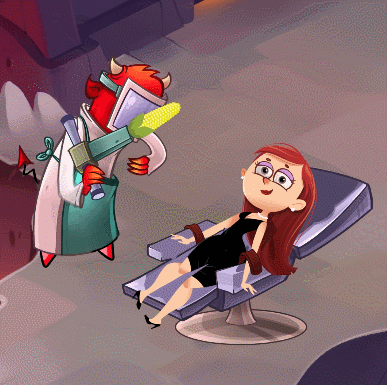When promoting mobile games, they are now increasingly resorting to mislids. We are talking about videos whose content does not match the content of the game. For example, the video shows a shooter, and the game itself is a strategy. Why this format of advertising has become popular with game publishers — we figured out together with market experts.
Methodology
In the material we tried to answer the following questions:
- 1. What is a mislid?
- 2. What is a mislid and how common is it?
- 3. Why have mislids become popular among developers?
- 4. What problems can be encountered when using mislids?
- 5. How do advertising platforms relate to mislids?
The material is written on the basis of five interviews. They were conducted with Mobio, AdSide Media, Apptica, AppQuantum and App Annie.
What is a mislid?
As we noted a little above, usually misliding (aka misleading or fake ads in English) means advertising that shows what is not in the game. As Eric Seufert, a former Wooga and Rovio marketer, writes: “This is an advertisement whose frames are completely unrelated to the game being promoted.”
There is an i3Stars channel on YouTube, whose author even started a special section in which he regularly compares fake ads with real gameplay of games.
There are enough similar videos on other channels. For example, a year ago, the popular streamer PewDiePie made an issue in which he was ironic about “experimental advertising”. The videos shown to them either did not show the gameplay, or were frankly staged.
Thanks to these examples, it may seem that there are no questions about what a mislid is. However, it turned out that there are enough nuances here. Many of our interlocutors said that it is not worth calling any advertisement whose content does not show the real gameplay of the game a mislide.
There are two types of creatives that many people confuse.
The first type is a mislid — a classic story using someone else's content. We are talking about the format in which the player is trying to attract a video or a banner with the image of another game. Sometimes even screenshots of a direct competitor are taken.
The second type, which today is mistaken for a mislid, is more correctly called a meta-gameplay creative. We are talking about a format that uses elements of the advertised game (art, sounds, UI elements), but mechanics that are not typical of the project. For example, a game character is taken and placed on one banner with mechanics that are not in the game itself. As a rule, a puzzle is used — a logical riddle with an obvious solution.
AdSide Media
The second approach does not contradict Seyfert’s words, because the advertising frames of such a creative can be associated with the game. Although the authors of the advertisement, who will follow it, have a very large freedom of action.
For this reason, most likely, the definition that the App Annie representative gives to the mislid is much stricter.
A mislid is any creative that does not reflect the basic game mechanics around which the game is built.
BDM, AM in Russia and CIS in App Annie
However, he also divides the advertising in demand among developers today into two types. The first type is directly a mislid, but the second is gameplay videos, which are preceded by non—game frames. As Alexey explains: “Such content helps to evoke emotions, attract attention.”
There are companies on the market that believe that there are even more types of advertising. For example, there are as many as four gradations in AppQuantum, and mislid is only one of them:
- advertising with real gameplay (80% of the video is filmed gameplay);
- storytelling advertising (gameplay is either very little or not at all, the main content is a demonstration of heroes, art elements or a plot);
- variations (a cross between a gameplay demonstration and storytelling);
- mislid (demonstration of gameplay mechanics that are not in the game).
By the way, in the definition of fake ads, AppQuantum is close to the position of App Annie.
A classic example of a mislid: in the commercial for match-3, they do not collapse the same pears, but offer to choose what to put out the fire in the living room.
Head of Publishing in AppQuantum
At the same time, AppQuantum allows the demonstration in advertising of content that is not in the game, but which reflects the essence of the game. As an example, the company cites its own case for the game Evil Clicker:
We have prepared a lot of creatives for the game. For them, we came up with new cool tortures, which were not in the game itself. They were drawn from scratch, taking into account the style and gameplay of the game.
We do not consider them to be mislids ourselves, although there was no part of the content shown in the game. But the essence of the mechanics, the style of the game, the humor inherent in it were displayed. So it quite passed as a gameplay advertisement.
In addition, those tortures that showed the coolest result as an advertisement were then added to the game. In fact, we not only promoted the game, but also tested new content for it.

Case from Evil Clicker
As you can see, the situation with what a mislid is is debatable. There is no common denominator.
For this reason, in order, as the English philosopher William of Ockham wrote, “not to multiply entities beyond what is necessary,” we decided by mislids to mean any advertising that embellishes the real gameplay or even shows content that is not directly related to the game.
Disclaimer: none of the companies we talked to use frames of other people’s games to promote (classic mislid). We used the concept of mislids in communicating with them (and in the text as a whole) solely for simplicity (except in cases where it is separately pronounced), so that each time we do not stop at the fact that there are videos that show the gameplay of the game, and there are commercials that use cinematics, art or what-or else game content adapted for advertising. The same applies to the demonstrated examples.
What is a mislid and how common is it?
The Mislids did not appear yesterday. At one time, there were videos in which the gameplay of Total War, Heroes of Might & Magic and even “Cossacks” was used to promote mobile strategies.
It is not customary to do this now, but this format was distributed in 2013-2014.
CEO of AdSide Media
Today, the main part of the mislids are humorous videos or interactive banners in which the user is offered to make a choice. Natalia Stepanova, a representative of the analytical service Apptica, identifies five main plots that are resorted to:
-
- putting things in order (the heroes repair or clean the apartment/house);
-
- how to get the treasure, aka how to loot? (the task is to solve a simple puzzle to get gold);
-
- survival (the user must make a choice for the heroes to survive);
-
- fateful choice (as a rule, the goal here is to choose a suitable weapon for combat);
-
- search for identical items.
There are no specific figures on how many percent of companies resort to such experience. But many people talk about popularity. For example, the authors of the i3Stars channel counted more than a dozen games that are promoted through advertising on the topic “How to get treasures?” Many of the titles are market leaders.
Some of our interlocutors also noted that such promotion is now popular with game publishers.
A similar format today is the engine of advertising. It works well, it is actively used by many companies.
CEO of AdSide Media
Mislids in the promotion of mobile games are a very popular topic. Many resort to this practice.
Head of non-ru traffic in Mobio
App Annie gives a more specific assessment of the situation. According to the company, almost all the games that have shown the fastest growth in revenue over the past two years in the category of “casual games with in-app purchases” were promoted either with the help of mislids or with the help of commercials where there is non-gameplay content.
Why have mislids become popular among developers?
The answer to the question about the reasons for the popularity of such a format should be divided into two aspects: historical and economic. The first explains what has become the driver of growth “here and now”. The second is why such a format is used at all.
Historical background
As we have already written, the mislids in the mobile game advertising market have been around for a long time. However, as meta-gameplay creatives, they have gained wide popularity only recently.
Head of marketing and PR in Apptica
Eric Seifert believes that the relaunch of the Facebook Ad Library in March 2019 acted as a Pandora’s box.
Recall that the Facebook Ad Library is a library of all commercials and banners that are currently active. The library is available to all Facebook users and has extensive search capabilities.
The tool itself was conceived by Facebook developers as a way to combat political trolls. However, it turned out to be very useful for game developers as well. With its help, it became easier for them to track the cases of competitors and leading teams in the market. They began to receive regular information about various marketing approaches, in fact, “first-hand”.
Among other things, everyone on the market has witnessed how the leaders resort to mislides and do not receive any fines or bans from the platforms. As a result, many other companies that recently played videos with real gameplay began to make a completely different format of creatives.
But these are indirect factors that caused the growth. The main reason for the current popularity of mislids is their effectiveness.
The effectiveness of mislids
Meta-gameplay creatives are mainly resorted to by games with high LTV.
High LTV (now it is observed in strategies and match-3) often leads to highly competitive procurement. Accordingly, where there is high competition, there is the most expensive user, and the highest percentage of mislid.
Head of Publishing in AppQuantum
One of the reasons for using mislid when promoting such games is that they do not differ in external attractiveness.
The gameplay of such titles is not expressive enough. It is unlikely that many players will be inspired by a video in which someone harvests. For this reason, advertising tries to surprise, catch up with drama, show conflict, which, of course, is absent in the game.
Head of non-ru traffic in Mobio
High niche competitiveness only worsens the situation. Many projects share not only one genre, but also similar meta-mechanics, style, interface solutions. Therefore, advertising the game with the help of real gameplay is obviously a losing, inefficient option.
Quite another thing is promotion with the help of funny videos, funny interactive, which is better converted into transitions than traditional advertising, where the actual gameplay is shown.
The only thing that matters when conducting a campaign is the payback of advertising. It's math. For example, if with the help of creativity I was able to buy an audience ten times cheaper and hook a whale who spent fifteen hundred dollars more than it took for the campaign, I was in the black. Maybe 95% of my audience fell off, but as a result, my math came together.
CEO of AdSide Media
A Mobio representative agrees with AdSide Media. Kapnin also notes that this ad works better compared to other formats.
When promoting, it is not so important whether it is a mislid or not. The main thing is: what results the audience attracted by advertising shows. If it is converted into regular and paying players, then why not use it? In general, such advertising is more effective because it is more straightforward, its task is not to tell about the product, but to make the target potential user click on it.
Head of non-ru traffic in Mobio
But not everyone is ready to name a specific difference between conventional conventional videos and mislids. Including due to the specifics of the market.
It is difficult to talk about the effectiveness of such advertising, since the main task of advertising is to lead to the installation of the application. The CTR of fake ads is really higher. But then everything depends on the game: how interesting it will be to the user, will he play it often and make purchases? I can say that, judging by the large number of fake ads that are diligently produced by large game publishers, such advertising copes with its task.
Head of marketing and PR in Apptica
AppQuantum turned out to be ready to voice how much fake advertising can raise downloads. However, the representative of the company also noted that with such involvement “there is a nuance”.
Head of Publishing in AppQuantum
In general, all our interlocutors agreed that the mislids have higher clickability, which leads to a cheaper cost of downloads.
What problems can you face when using mislids?
Against the background of the story about how mislids increase conversion from advertising in a competitive environment, it may seem that this is a worthwhile tool. Especially considering how many companies today resort to such a method of promotion. However, there are a number of factors that need to be “kept in mind” by those who are going to try to work with mislids.
For example, both Ilya from AppQuantum and Alexey from App Annie warn that if the percentage of those paying for traffic attracted in this way turns out to be low, then the economy “may not converge.” It is for this reason, for example, that it is absolutely not worth using complex meta-narrative advertising to promote hyper-casual titles.
We tried to promote them in this way, but it didn't work. The thing is that we are clinging to an audience that is willing to pay. However, such games are devoid of complex monetization, players have nothing to pay for in them.
CEO of AdSide Media
So within the framework of the hyper-casual genre, the main selling creative remains videos with real gameplay.
The less visual your gameplay is, the better the mislids will work with respect to videos with real frames. Hyper-casual games have a visual and attractive gameplay, and the user is already very cheap. That is why there are fewer mislids in this direction.
Head of Publishing in AppQuantum
But other mobile games, built on a repetitive or recognizable gameplay, already, it turns out, there is no choice. If we are talking about a game in a popular genre, its developer is forced to approach advertising as creatively as possible. However, only in one case: if the LTV of the game allows you to do this, i.e. it will “forgive” attracting a lower-quality audience.
The potential problems with mislids do not end there. Ilya Tumenko identified four problems that a team using mislids may also face.
Firstly, mislids can spoil relations with platforms. If you do 100% misliding on large volumes, which is guaranteed to lead to complaints from users, partners will not be thrilled.
Secondly, users will begin to underestimate the rating of the application.
Thirdly, behavioral metrics will change. Imagine that part of the audience initially mistook your game for another one. It is fair to expect that their behavior will be different from that of the target audience. This will affect how much you earn from advertising. That is, with strict mislides in UA, your eCPM in monetization will fall, since your ad impressions will fall on, on average, lower-quality users who tend to fall off faster and pay less.
Fourth, long-lasting side effects. Suppose you use a source that automatically optimizes purchases, some of the settings of which are closed from you, are in a black box. Because of the mislids, this source can independently reorient itself to an audience that is inclined to click on the mislids. And then the purchase of advertising for another type of creatives will work worse.
Head of Publishing in AppQuantum
AdSide also gives a detailed assessment.
We see the excitement of customers who, when launching such campaigns, see how their rating decreases. There are players who feel cheated by not seeing the appropriate mechanics in the game. They are the ones who start to minus the game.
Some companies, faced with such an experience, say that they do not want meta-gameplay creatives now. They are worried about the rating of the game. They are worried that the page in the store after fake advertising will be filled with negative reviews.
CEO of AdSide Media
So it turns out that mislids, for all their popularity among teams, lead to dissatisfaction with part of the audience. However, there is no mass reaction yet. Although there are petitions calling for a lawsuit for mislidy.
It is important to note: as far as the comments can be judged, users are hostile primarily to real mislids who pretend to be a game of another genre. The audience is more loyal to funny videos with elements from the game.
How do advertising platforms treat mislids?
The absence of high-profile viral stories related to mislids is probably just one of the reasons why the sites (the same Facebook Ads) are still looking at such advertising “through their fingers”. The second reason also lies on the surface. Marketers use mislids to promote products that are distributed for free.
Here, advertising is not checked against the product. Of course, there are general requirements, there is a law on advertising, there is a chance that your office may be blocked due to negative reactions of users to the ad, due to the inconsistency of creatives with the policy of the advertising platform. But you don't have to be a mislid to do that. As for the mislids, if they are not on the verge of what is allowed and are served in accordance with the existing rules for creating creatives, then they will most likely not be blocked.
Head of non-ru traffic in Mobio
Deep evaluation of the platform, as a rule, is not engaged in. The formal rules limiting misliding are as vague as possible so far. Therefore, according to Tumenko, in relation to the same creative, in one case, conditional Facebook may refuse, in another — to shake a finger, they say, let it spin, but we do not approve, and in the third — not to pay attention at all.
He also notes that the platforms now have a wait-and-see policy:
If the media criticizes this approach more often, if more users underestimate reviews in stores and criticize it on various UGS sites, then perhaps Facebook and others will decide to restrict this tool more or even start blocking it.
Head of Publishing in AppQuantum
However, Alexey from App Annie is sure that in case of a ban, you should not expect a serious change in the market situation.
Tightening the rules will not eradicate mislidy. Rather, it will be like an arms race: you can always add a mini-game based on a mislide to the product itself. In this case, the requirements will not be formally violated.
BDM, AM in Russia and CIS in App Annie
No tightening is planned yet. However, some large gaming companies are introducing game mechanics from advertising into their products. Maybe just in case.
***
We will be glad to hear your comments and questions to the heroes under the article or in our social publics.
Also on the topic:
Is there any news? Share it with us, write to press@app2top.ru






